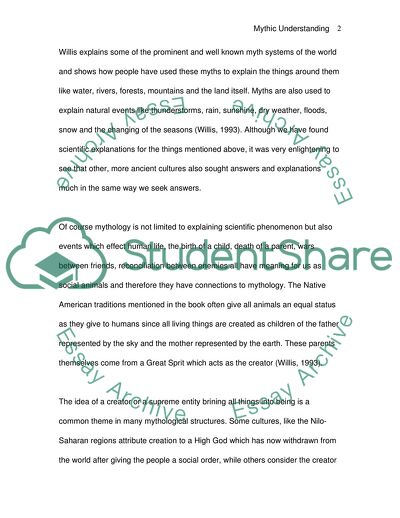
- Home
- Free Samples
- Premium Essays
- Editing Services
- Extra Tools
- Essay Writing Help
- About Us
- Studentshare
- Subjects
- Miscellaneous
- Changes in my understanding of mythology after taking mythology course
Changes in my understanding of mythology after taking mythology course - Essay Example

- Subject: Miscellaneous
- Type: Essay
- Level: Ph.D.
- Pages: 4 (1000 words)
- Downloads: 0
- Author: dstrosin
Extract of sample "Changes in my understanding of mythology after taking mythology course"
I know realize that every culture around the world has had a myth structure of some sort to explain the world around them. Myths can be seen as the human desire to know, understand and given expression to observable phenomenon. There is a whole range of ideas and myth systems with certain ideas which seem to be common amongst many cultures and others which differ from area to area. It can also be observed that mythology has a great connection with the land and the climate of the people connected with the myths.
Willis explains some of the prominent and well known myth systems of the world and shows how people have used these myths to explain the things around them like water, rivers, forests, mountains and the land itself. Myths are also used to explain natural events like thunderstorms, rain, sunshine, dry weather, floods, snow and the changing of the seasons (Willis, 1993). Although we have found scientific explanations for the things mentioned above, it was very enlightening to see that other, more ancient cultures also sought answers and explanations much in the same way we seek answers.
Of course mythology is not limited to explaining scientific phenomenon but also events which effect human life, the birth of a child, death of a parent, wars between friends, reconciliation between enemies all have meaning for us as social animals and therefore they have connections to mythology. The Native American traditions mentioned in the book often give all animals an equal status as they give to humans since all living things are created as children of the father represented by the sky and the mother represented by the earth.
These parents themselves come from a Great Sprit which acts as the creator (Willis, 1993). The idea of a creator or a supreme entity brining all things into being is a common theme in many mythological structures. Some cultures, like the
...Download file to see next pages Read More
- TERMS & CONDITIONS
- PRIVACY POLICY
- COOKIES POLICY